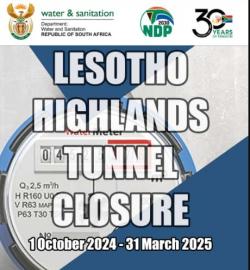
Water and Sanitation Minister Pemmy Majodina and her counterpart from the Kingdom of Lesotho, Minister Mohlomi Moleko, have expressed optimism on the state of readiness for the two countries to carry out the six-month maintenance closure of the Lesotho Highlands Water Project (LHWP) tunnel.
“Given the temporary halt in water deliveries, it is essential to use water sparingly and avoid wastage during this time. Despite preparations already made by government to ensure continued supply of water, it is crucial that we collectively minimise the impact on all of us through responsible consumption of water during this time,” Majodina said.
The two Ministers held a virtual meeting on Thursday, 26 September 2024 with a view to assess the state of readiness ahead of the tunnel closure from 01 October 2024 to 31 March 2025, which is aimed at undertaking maintenance work on the transfer and delivery tunnels of the LHWP.
The planned maintenance forms part of the ongoing commitment by the two governments to ensure long-term sustainability and integrity of the infrastructure of the LHWP.
“During the discussions between the two Ministers, there was a palpable agreement that the maintenance work should be carried out effectively and within the scheduled six-month period.
“The work required to be undertaken during the closure of the tunnel includes grit-blasting the steel-lined section around the entire circumference and re-applying corrosion protection on the tunnel lining, as well as other maintenance and repair work identified during the 2019 maintenance shutdown,” the Department of Water and Sanitation said on Monday.
This work is expected to protect the infrastructure for another 20 - 30 years.
The closure of the LHWP tunnel will affect the Phase I Water Transfer and Delivery Tunnels. This will result in the total shutdown of the water delivery system for six months.
“During this time, there will be no transfer of water from the Katse Dam to Muela Hydropower Station (Transfer Tunnel – 45km), which will result in the stoppage of power generation at the Muela Hydropower Station in Lesotho.
“Additionally, there will be no delivery of water from Lesotho to South Africa through the 37km delivery tunnel. (Delivery Tunnel South 15km and Delivery Tunnel North 22km).
“Despite the impact on water transfer, both Ministers have assured that during the six-month maintenance period, citizens should not be alarmed, as there have been comprehensive measures taken by the Department of Water and Sanitation, working collaboratively with municipalities and water boards to ensure water security through water transfer within the Integrated Vaal River System (IVRS),” the department said.
Both Ministers acknowledged that although the tunnel closure will be a short-term inconvenience, it is crucial to undertake it in order to prevent long-term inconveniences in the future.
In preparation for this planned closure, both governments took proactive measures to ensure that the maintenance will be conducted smoothly, with minimal disruption and to the benefits that accrue to Basotho and South Africans from the LHWP.
“This proactive measure has allowed South Africa to receive most of its annual water deliveries, ensuring that both the water supply and the royalties revenue that Lesotho receives from those deliveries are minimally impacted.
“The Lesotho government has also put in place concrete plans to secure additional electricity supply in the region and to ensure that reliable supply of electricity continues in Lesotho during this period,” the department said.
To mitigate the impact of the tunnel closure on water availability in the affected areas in South Africa, the IVRS, which consists of 14 interconnected dams, including the Vaal, Sterkfontein, Grootdraai and Bloemhof Dams (which is augmented by the Katse and Mohale Dams in Lesotho), has enough water for the duration of the maintenance period.
“The dams are linked to each other by a system of rivers, canals, tunnels, pipelines, and pump stations. The Department of Water and Sanitation manages the IVRS as a system, in which water can be transferred from one part of the system to another, as and when required.
“The Government of South Africa has undertaken a thorough analysis to assess the risk to the performance of the IVRS because of the tunnel closure and to determine the impact of the tunnel closure on water availability to users.
“The analysis confirmed that the impact of the tunnel closure on the overall IVRS will be minimal, as most dams in the IVRS will be relatively full at the time of closure,” the department said.
Comprehensive technical and operational plans have been put in place to ensure minimal disruption to the everyday lives of the people in both countries.
“All resources for the implementation of the maintenance work have been mobilised, and preparations are ready for the work ahead,” the department said. - SAnews.gov.za


